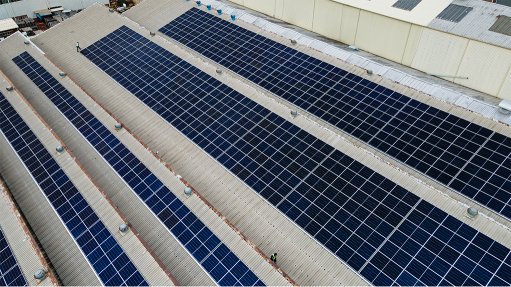
THE SMART CHOICE Actom Smart Technologies division Static Power has installed a 1.1 MW solar photovoltaic grid-tied system at its factory in Knights Gauteng
After a year of planning and installing alternating-current and direct-current solutions, standby equipment manufacturer Static Power has commissioned a 1.1 MW solar photovoltaic (PV) grid-tied system at its ACTOM Medium Voltage Switchgear manufacturing facility in Knights, Gauteng.
Static Power is a business unit within the division of Actom Smart Technologies which is within the ACTOM group.
ACTOM is a major supplier of electrical equipment, services and balance of plant to the renewable-energy sector.
The 1.1 MW plant is expected to reduce the peak load consumption of the Medium Voltage Switchgear factory by about 50% during hours of peak irradiance.
“The PV installation is positioned on the roof of the switchgear factory, as it is the largest consumer of power on the site,” says Static Power engineering manager Jaco Weyers.
The factory’s roof had the optimal structure and orientation to make it the “perfect place” to install the system.
Carbon-negative solutions provider The Green Company facilitated the planning and installation of the PV plant and its remedial roof works, which totalled about R14-million.
“Two structural engineers were involved in the simulation design of the total roof structure to ascertain loadbearing capacity,” he adds.
The roof had to be inspected to ensure that the structure could hold the additional load of the PV panels and to ascertain if structural reinforcements were required.
Consequently, a solution to accommodate the additional weight of the solar panels and wiring was implemented.
Further, the relevant approvals were acquired from the Ekurhuleni municipality for the installation of embedded generation.
Solution of Choice
Global solar energy provider Trina Solar’s TSM-DE21 660 W is a monocrystalline solar PV module with a maximum efficiency of 21.6%, and it was selected as the most appropriate solar panel for the installation.
The choice for such a high-powered module was driven by the limited space on the roof and Static Power needing to achieve the maximum possible power output per square metre on the roof.
A bifacial panel was not considered, owing to the dusty environment and the manner in which the panels are mounted flush to the roof, which would have made it difficult to clean the underside of a bifacial panel.
PV system provider SMA Solar Power’s Sunny Tripower Core2 110 kW inverter was chosen because of its ruggedness, high efficiency and proven performance. Ten of the inverters and 1 696 of the PV panels have been installed, delivering a potential maximum direct current peak of about 1 120 kW.
“The system is grid-tied and in the event of the grid not being available, it will automatically shut down and isolate from the grid,” says Weyers.
Importantly, the system is split into two discrete systems of 550 kW, each feeding into different low-voltage supply to the factory.
The factory load is such that the maximum power generated by the PV system will immediately be used and, if the factory load declines, any additional energy will be diverted to other ACTOM business units on the same premises.
The purpose of the system is to reduce the energy consumed from the grid, and to consider future options, including running the solar installation in parallel with diesel generators to decrease the costs incurred when using only the generators.
Owing to the average yearly lightning ground flash densities of the area around Knights, lightning rods were installed on the solar structure to intercept and safely absorb lightning strikes away from the PV system, rather than leaving it vulnerable.
This installation coincides with Actom’s drive to produce electrical products with minimum impact to the environment by generating power through renewable energy rather than loading the electricity grid.
Weyers concludes that ACTOM is investigating further renewable-energy options on all group sites to lower its footprint globally.